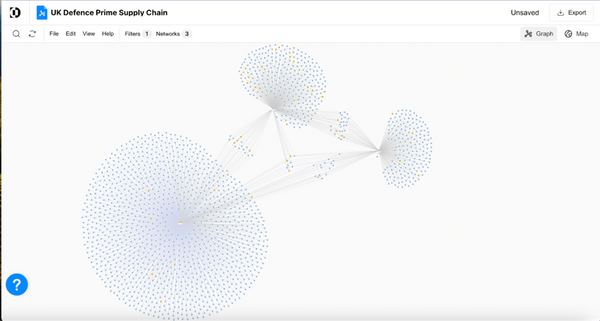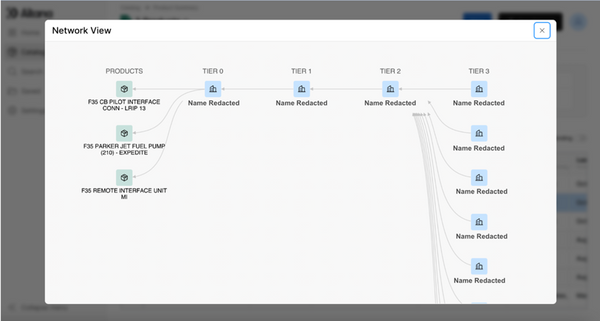Building the future of supply chain advantage
In recent years, disruptions to supply chains have affected not only the national security community, but have also driven large-scale change across society. The lack of PPE during COVID-19, critical mineral shortages, repeated disruptions to shipping from natural disasters and armed attack, and the challenge for Western states in replenishing Ukrainian ammunition stockpiles all point to structural problems in how our societies source the goods they need. Taken together, these crises have driven a pervasive realisation that resilient supply chains are foundational to every aspect of national security. Before any of these concerns can be addressed though, we must first understand how our supply chains look from end to end - a colossal, daunting task. Or is it?

A multi-tier supply chain for a major UK Defence Prime, demonstrating the breadth and depth of sub-tier trade data available, but also highlighting the need for systematic analysis of sub-tier risk.
The Promise of Data and AI for Supply Chain Advantage
Today, modern data architecture and AI-driven analytics make it possible to derive insight from vast quantities of data, empowering national security users to understand trends at a level of breadth and granularity that the human mind alone cannot grasp. In the data-rich world of supply chain, similar approaches can enable users to predict the effects of crises, detect bad actors in complex systems, and efficiently allocate scarce resources. Such an approach is critical to achieving Supply Chain Advantage – turning a vast logistical “tail” into something which can be seen, understood, and leveraged to achieve the goals of national security.
Using global trade data as the mechanism to be able to generate sufficient sub-tier visibility into the movement of goods around the world, the national security community can stop tolerating risk through accepting ‘unknown unknowns’ and move to a proactive footing. This will enable us to achieve key goals, including:
- Blue Force Resilience - The ability to systematically situate our own supply chains in the context of global trade, surfacing risk before it is exploited by adversaries.
- Adversary Targeting - The ability to understand criticality in Red Force supply chains and exploit these opportunities to achieve our own aims.
- Collaboration - A shared data substrate and platform that embraces the reality of unclassified data to permit real interoperability between governments and industry, and between nations.

A three-tier supply chain for input systems for the F35, using AI to process bulk trade data. Pursuing Value Chains as opposed to a “mapping” approach to such systems entails significantly more cost, time, and frequency of revision as relationships change.
Break Down Stovepipes to Build a Common Operating Picture
Historically, supply chain has been the preserve of logisticians, both in the private sector as well as in the national security community - something that has significantly constrained the opportunity that is created by framing supply chain insight through the lens of global trade. If legacy perspectives are broadened, and supply chains are viewed as an opportunity for real advantage, rather than as a risk to be mitigated, this creates the opportunity to bring together global trade data in a way that enables massive opportunity for the national security community at the same time as mitigating key risks. Delivering this, however, means organisational change; it means investing in robust data processing power and enduring visibility at the level of sub-tier suppliers. The outcomes will drive massive compounding value. Viewed as an enabling effect across logistics, intelligence, targeting and operations - rather than simply as an action in support of logistics - focussing on supply chain advantage gives national security planners a level decision of advantage previously considered unachievable.
Move Beyond Mapping to Achieve Real-Time Visibility
To apply this in a national security context, supply chain visibility needs to be redefined. The traditional view that supply chains can be mapped through a series of time constrained, static, surveys - to a standard that is sufficient for a 21st century threat landscape - falls far short of the mark in 2024. Rather than mapping individual supply chains, the UK national security community needs a dynamic common operating picture from which insights are derived. This means that rather than creating routes to surface individual risks in specific systems, there is an enduring map that can be leveraged in perpetuity. Not only does this allow the protection of critical friendly force supply chains, but it generates the freedom to understand global supply chains, such as those of adversaries and partners in a way that maximises resources and enables real decision advantage. Ultimately this is the kind novel and creative leveraging of data at scale that will put the UK on the front foot when it comes to strategic competition.
Build a Platform for Public-Private Partnerships
The vast majority of actionable supply chain data is not currently generated by the government – it is in the hands of the private sector, including not only large defence “primes,” but also multinational logistics carriers and smaller suppliers. These firms, in turn, have their own supply chains, which often span the globe and introduce risk at one, two, or three tiers removed from the end customer. Any attempt to understand the supply chain must start by building public-private partnerships that enable efficient and secure data-sharing in a way that protects the unique sensitivities of the world of national security. This calls for creative data-sharing architectures such as federated learning, which enable the transfer of AI-derived insights without the direct sharing of sensitive data, as well as embracing the freedoms of using commercially derived data that does not come with inherent security constraints.
This is the key premise of Supply Chain Advantage - by bringing together the right people, the right data, and the right public-private partnerships, the UK can not only mitigate risk to critical supply chains, but also create an opportunity to achieve massive strategic advantage through superior insight. In a future that promises to be more disruptive than the present, Supply Chain Advantage will be foundational to our ability to secure our nation, project our power abroad, and secure our common prosperity.
National Security updates
Sign-up to get the latest updates and opportunities from our National Security programme.





